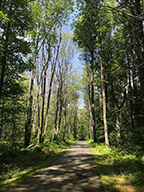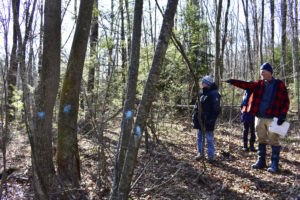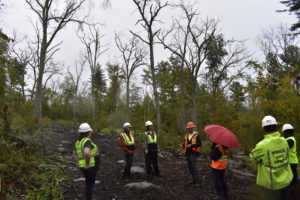Tree harvesting is complete as of fall 2020. The full paved trail is now open. Please call 413-452-1302 with any questions. (Read the forester’s final report on Ludlow tree harvesting – April 2021)
Gypsy Moth Infestation in the Ludlow Reservoir Watershed
In 2016, a gypsy moth infestation was discovered in the Ludlow Reservoir watershed forest, resulting in irreversible and eventually fatal damage to a large number of oak trees. In response, the Commission implemented forest management activities, including tree harvesting, within the Ludlow Reservoir watershed forest.
What is a watershed forest?
The Ludlow Reservoir was built in the 1870s, and now serves as an emergency backup water supply for the Commission’s public water system. The primary purpose of the 1,400 acres of forest surrounding the reservoir is to protect water quality by acting as a natural buffer from surrounding development, and as a natural filter of potential contaminants.
A forest that is diverse in age and species provides the best water quality protection. A good watershed forest is biologically diverse (i.e. numerous species), structurally diverse (i.e. wide range of tree ages), and able to naturally regenerate itself. These qualities make a forest more resilient to stressors such as disease and invasive pests, thus supporting water quality protection.
What are gypsy moth infestations?

Defoliation of the oak tree canopy, August 2018.
Gypsy moths are an invasive species that was accidentally introduced into the environment in Medford, Massachusetts, in 1869. Since then they have been a reoccurring and spreading problem in northeast hardwood forests. Gypsy moths feed on the foliage of mature trees, stripping the trees’ ability to photosynthesize and generate the energy needed to heal and grow. Successive defoliations may kill trees outright or leave them susceptible to secondary pests and pathogens.
The last gypsy moth infestation at Ludlow Reservoir was in the 1980s. Gypsy moths prefer oak trees, a significant part of the forest cover in the Ludlow Reservoir watershed. In summer 2018 the Commission’s consulting forester documented that trees affected by successive gypsy moth infestations did not regenerate with a second set of leaves, and reported that mortality of a large number of oak trees is imminent. (Read the forester’s report to the Commission.)
What were the goals of tree harvesting in response to gypsy moths?
There is no known method to reverse gypsy moth damage. Tree harvesting served the following goals:
- To promote greater species diversity including trees and shrubs that need to grow in full sun
- To remove trees that pose a public safety hazard
- To capture timber value contained within trees fatally affected
How was tree harvesting managed?

A MA Licensed forester describes the tree markings that will guide the harvesting, December 2018.
A licensed forester evaluated each stand of trees identified as suitable for harvesting and mark each tree to be removed or retained. The goal of this careful selection was to beneficially shape future forest conditions to protect water quality. In some cases, other issues were also addressed, such as thinning of over-crowded white pine trees.
The Ludlow Reservoir watershed land is protected by a conservation restriction held by the Massachusetts Division of Fish and Wildlife, which requires an approved forest management plan. The plan was approved on November 6, 2018. Cutting plans for the tree harvest were guided by the Ludlow Reservoir forest management plan, and were approved by the Department of Conservation and Recreation on November 20, 2018. The forest cutting plans were also reviewed by the Ludlow Conservation Commission and the Natural Heritage and Endangered Species Program (NHESP). A Massachusetts Licensed Forester will oversee harvesting activities on behalf of the Commission.
Read the forester’s final report on Ludlow tree harvesting (April 2021)
Why not just let nature just take its course?
In many areas, it will. Trees will die and decompose in place in areas that are not suitable for tree harvesting such as in wet areas or where the land is too steep. The look and composition of the forest in those areas may change significantly from what it is today. In the other areas, harvesting will be utilized as a strategy to promote the full spectrum of tree and shrub diversity including trees and shrubs that need to grow in full sun.
How will this impact public recreation at Ludlow Reservoir?
The landscape and tree canopy at Ludlow Reservoir will change significantly now that tree harvesting is complete, and will be noticeable to visitors. In some areas along the recreational path, taller oak trees will be removed resulting in much more sunlight on the path. The terrain will also look more disturbed. In areas where harvesting will not take place, more dead trees will be visible as the forest cycle progresses. The impacts of harvesting will become less visible over time as the forest continues to grow.

Viewing an area with completed tree harvesting, September 2019.
Who can I contact to ask questions?
If you have any questions about the forest management activities, please contact Jaimye Bartak, Communications Manager, at jaimye.bartak@waterandsewer.org or 413-452-1302.